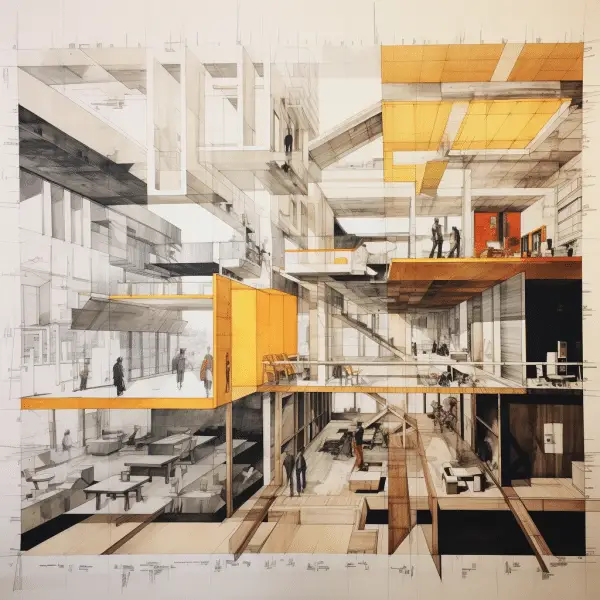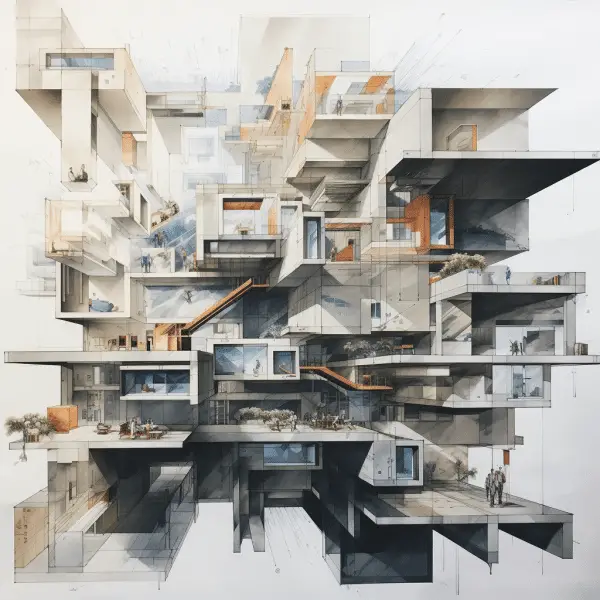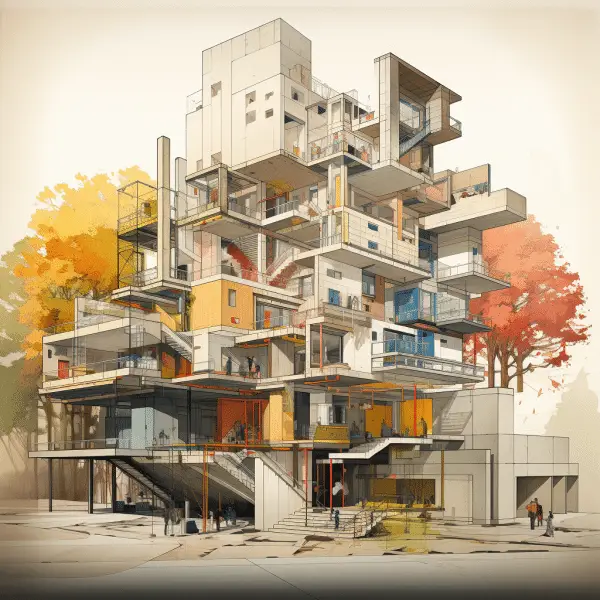Crafting an Outstanding Architecture School Portfolio Guide
Creating a portfolio for architecture school is a crucial step towards building your future as an architect. It requires time, dedication, and effective time management to showcase your skills, experience, and potential in the best possible way. In order to stand out among the competition, it is important to not only showcase your work effectively but also document your progress and achievements along the way.
Key Takeaways:
- Effective time management plays a significant role in creating an architecture school portfolio.
- Understanding the requirements of architecture programs is essential to tailor your portfolio accordingly.
- Including a clear mission statement and personal information helps showcase your individuality.
- Showcasing design skills and potential is crucial to demonstrate your understanding of form and space.
- Choosing the best projects that align with your strengths and interests is important.
Mastering Effective Time Management
Effective time management is essential when creating your architecture school portfolio to ensure that you can showcase your skills and document your design process effectively.
Here are some tips to help you master time management:
- Plan and Prioritize: Create a detailed schedule and prioritize your tasks based on their importance and deadlines. Break down larger tasks into smaller, manageable steps to stay organized.
- Set Realistic Goals: Set realistic goals for each day or week, ensuring that they align with the overall timeline for completing your portfolio. This will help you stay focused and motivated.
- Avoid Procrastination: Procrastination can lead to unnecessary stress and compromised quality of work. Be proactive and tackle tasks as soon as possible, rather than leaving them until the last minute.
- Eliminate Distractions: Minimize distractions during your dedicated work time. Turn off notifications on your phone, close unnecessary tabs on your computer, and create a quiet, focused environment.
- Take Breaks: Allow yourself short breaks throughout your work session to recharge and maintain productivity. Use these breaks to stretch, hydrate, or take a quick walk to refresh your mind.
These time management tactics can help you create a great architecture school portfolio that highlights your talents and design process.
Creating an architecture school portfolio requires time management to display your skills and document your design process.

“The bad news is time flies. The good news is you’re the pilot.” – Michael Altshuler
Understanding the Requirements of Architecture Programs
Know the program criteria before constructing your architecture school portfolio. Portfolio submission requirements vary each architectural program. Contacting the program personally is recommended to verify your portfolio matches their criteria and stands out among other applicants.
Contacting the program lets you learn about their portfolio requirements, including the amount of projects, preferred documentation forms, and any prompts or themes. By knowing these requirements, you can tailor your portfolio to highlight your talents and match the program’s preferences.
Additionally, contacting the program shows your proactiveness and genuine interest in their university. It helps you to engage with academics and admissions personnel and gain insights to create a portfolio that matches the program’s beliefs and objectives.
| Key Takeaways: |
|---|
| Before creating your architecture school portfolio, contact the specific program to understand their requirements. |
| Gather information about the number of projects, preferred documentation formats, and any prompts or themes. |
| Tailor your portfolio to showcase your strengths and align it with the program’s preferences. |
| Establish a connection with the program and gather insights from faculty or admissions staff. |
Summary:
Understanding the requirements of architecture programs is essential for creating a successful portfolio. By contacting the specific program, you can gather detailed information about their expectations and tailor your portfolio accordingly. This proactive approach demonstrates your genuine interest in the institution and allows you to establish a connection with the program.
Crafting a Clear Mission Statement
A well-crafted mission statement in your architecture school portfolio can provide a clear sense of purpose and highlight your unique interests. It serves as a guiding statement that defines your goals, values, and aspirations as an architect.
- Start by reflecting on your personal and professional values. Consider what drives you to pursue a career in architecture and what specific aspects of the field resonate with you.
- Identify your unique interests and areas of specialization within architecture. Highlighting these in your mission statement can help you stand out from other applicants.
- Utilize concise and impactful language to convey your message effectively. Avoid generic statements and focus on expressing your individuality and passion for the field.
Remember to keep your mission statement aligned with your overall portfolio theme and objectives. It should complement the visual elements of your portfolio and provide a cohesive narrative that showcases your skills, experience, and potential as an architect.
Sample Mission Statement:
“As an aspiring architect, my mission is to create designs that seamlessly integrate functionality and aesthetic appeal. I am passionate about sustainable architecture and strive to create environmentally conscious spaces that enhance the quality of life for individuals and communities. With a keen eye for detail and a deep appreciation for innovative design solutions, I am dedicated to delivering exceptional projects that contribute to the built environment in a meaningful way.”
By incorporating a well-crafted mission statement into your architecture school portfolio, you can establish a strong foundation for presenting your unique identity and aspirations to potential architecture programs and employers.
| Tips for Crafting an Effective Mission Statement: |
|---|
| 1. Be authentic and true to yourself. Your mission statement should reflect your genuine passion and interests in architecture. |
| 2. Keep it concise. A mission statement should be brief and impactful, capturing the essence of your goals and values. |
| 3. Use powerful language. Choose words that evoke your enthusiasm and commitment to architecture. |
| 4. Align it with your portfolio. Ensure that your mission statement complements the overall theme and visual elements of your portfolio. |
Showcasing Design Skills and Potential
Your architecture school portfolio should effectively showcase your design skills and potential, demonstrating your understanding of form, space, and your ability to observe and record. The portfolio serves as a visual representation of your creative abilities and should captivate the attention of admissions committees.
To showcase your design skills, consider including a variety of projects that demonstrate your versatility and ability to innovate. This could include architectural drawings, 3D models, sketches, and photographs. Including a mix of different mediums and styles will highlight your ability to think beyond conventional boundaries and adapt to various design challenges.
To further emphasize your potential, it’s important to showcase your design process. This can be done by including initial sketches, concept development, and the progression of your ideas. Admissions committees are interested in seeing how you approach a project and the thoughtfulness of your design decisions. By documenting your design process, you demonstrate your ability to think critically, problem-solve, and communicate your ideas effectively.
Design process
In addition to showcasing your skills and potential, it’s crucial to pay attention to the overall presentation of your portfolio. Organize your projects in a logical and visually appealing manner, allowing the viewer to easily navigate through your work. Consider using tables to present project descriptions, including information such as project name, location, scale, and the role you played in the design. Including captions or brief explanations for each project will provide context and allow the viewer to better understand your work.
Remember, your architecture school portfolio is a reflection of your abilities, creativity, and potential as an architect. Take the time to curate a portfolio that effectively showcases your design skills, demonstrates your understanding of form and space, and exhibits your ability to observe and record. By presenting your work in a professional and visually appealing manner, you will leave a lasting impression on admissions committees and increase your chances of being accepted into your desired architecture program.
Key Points:
- Showcase a variety of projects and mediums to demonstrate versatility.
- Highlight your design process to showcase critical thinking and problem-solving skills.
- Organize your portfolio in a logical and visually appealing manner.
- Include project descriptions with relevant information for context.
- Present your work in a professional and visually captivating way to leave a lasting impression.
| Portfolio Components | Key Considerations |
|---|---|
| Design Projects | Include a variety of projects and mediums to showcase versatility. |
| Design Process | Document the progression of your ideas and highlight critical thinking. |
| Organization | Present your work in a logical and visually appealing manner. |
| Project Descriptions | Include relevant information to provide context for each project. |
| Professional Presentation | Create a visually captivating portfolio to make a lasting impression. |
Selecting the Best Projects
Your architecture school portfolio should include the greatest projects that demonstrate your skills and match the office or program you are applying to. Your portfolio should highlight your strengths and hobbies to stand out from the competition and show your architectural potential.
A good portfolio showcases your design, technical, and creative skills. Include a variety of projects to demonstrate your versatility and ability to use multiple design approaches and styles. You must demonstrate your form, space, observation, and recording talents through multiple mediums.
It’s tempting to include every project you’ve worked on, but a succinct portfolio should only include your best. Quality trumps quantity. Carefully assess each project and chose those that best showcase your skills and match the office or program’s profile. This will show potential companies and colleges that you can meet their needs.
Table: Examples of Project Selection Criteria
| Criteria | Explanation |
|---|---|
| Relevance to the Office | Select projects that align with the office’s focus and expertise. Consider their previous work and projects. |
| Design Complexity | Showcase projects that demonstrate your ability to tackle challenging design problems and create innovative solutions. |
| Diversity of Project Types | Include a variety of project types (residential, commercial, institutional) to showcase your versatility. |
| Technical Skills | Highlight projects that showcase your technical proficiency, such as projects with detailed technical drawings or complex construction details. |
Remember that your architecture school portfolio shows your potential as an architect, so display it thoughtfully and cohesively. By choosing projects that match your aims and the office or program’s profile, you may construct a portfolio that impresses potential employers or admissions committees and boosts your chances of success.
Balancing Theoretical Projects and Technical Drawings
While including theoretical projects and technical drawings can be beneficial in your architecture school portfolio, it is important to strike a balance and not overwhelm the portfolio with excessive technical details. The purpose of including theoretical projects is to showcase your creativity, innovative thinking, and ability to conceptualize designs. On the other hand, technical drawings demonstrate your proficiency in translating those concepts into practical, detailed plans.
To strike the right balance, consider selecting a few key theoretical projects that highlight your design thinking skills and innovative ideas. These projects should effectively communicate your ability to develop unique concepts and push the boundaries of traditional architecture. Including a variety of mediums such as sketches, renderings, and models can help to showcase your design process and creative problem-solving abilities.
On the technical side, it is essential to include a selection of well-executed technical drawings that showcase your understanding of architectural principles, construction techniques, and attention to detail. These drawings should demonstrate your ability to convey complex information in a clear and concise manner. Consider including plans, sections, elevations, and construction details that highlight your technical skills and knowledge.
By carefully selecting and balancing the inclusion of theoretical projects and technical drawings, you can create a portfolio that highlights both your creative vision and technical proficiency. Remember to curate your portfolio to ensure that each project contributes to an overall narrative and showcases your strengths and interests as an aspiring architect.
| Theoretical Projects | Technical Drawings |
|---|---|
| Project 1: XYZ Pavilion | Technical Drawing 1: Floor Plan |
| Project 2: Sustainable Housing Complex | Technical Drawing 2: Section |
| Project 3: Adaptive Reuse of Historic Building | Technical Drawing 3: Construction Detail |
The Importance of Honesty and Truthfulness
Honesty and truthfulness are crucial when creating your architecture school portfolio and resume, as presenting your experiences and achievements accurately is essential. It is important to showcase your work in a way that reflects your skills and potential, but it should always be based on reality.
When compiling your portfolio, it is tempting to embellish details or exaggerate your accomplishments. However, this can ultimately backfire and harm your chances of success. Admission committees and potential employers value honesty and integrity, and they will appreciate a portfolio that accurately represents your abilities and accomplishments.
It is essential to provide truthful information about your projects, including your level of involvement and the outcomes achieved. This will help ensure that your portfolio is an accurate reflection of your capabilities as an architect.
Table: Benefits of Honesty and Truthfulness
| Benefit | Description |
|---|---|
| Building Trust | Honesty establishes trust with admission committees and potential employers, making them more likely to consider you for opportunities. |
| Personal Integrity | Being truthful showcases your personal integrity and commitment to ethical standards, which is highly valued in the field of architecture. |
| Accurate Assessment | Presenting your experiences and achievements accurately allows admission committees and potential employers to make a fair assessment of your abilities and potential. |
By being honest and truthful in your portfolio and resume, you demonstrate your professionalism and integrity. Remember that your portfolio is not just a collection of projects, but a representation of who you are as an architect. It is a reflection of your skills, knowledge, and character, and it should be presented with honesty and authenticity.
Emphasizing Your Technological Skills
In today’s digital age, emphasizing your technological skills in your architecture school portfolio is essential to showcase your proficiency in design software and other relevant tools. As an architect, having a strong command of technology enables you to create visually stunning designs and effectively communicate your ideas to clients and colleagues.
To highlight your technological skills, consider including a table in your portfolio that outlines the software you are proficient in. This can include industry-standard programs such as AutoCAD, SketchUp, Revit, and Adobe Creative Suite. Be sure to indicate your level of proficiency, whether it’s beginner, intermediate, or advanced, to provide a clear picture of your capabilities.
Additionally, consider incorporating visual examples of your work created using these software programs. This could involve including renderings, 3D models, or interactive virtual tours that showcase the depth and complexity of your designs. Demonstrating your ability to utilize technology to bring your ideas to life will undoubtedly impress admissions committees and potential employers.
| Software | Level of Proficiency |
|---|---|
| AutoCAD | Advanced |
| SketchUp | Intermediate |
| Revit | Beginner |
| Adobe Creative Suite | Advanced |
In conclusion, the architectural field is becoming increasingly reliant on technology, and showcasing your proficiency in design software and other relevant tools is crucial for success. By emphasizing your technological skills in your architecture school portfolio, you can not only demonstrate your ability to navigate the digital landscape but also exhibit your creativity and innovative thinking. Remember to provide concrete examples of your work and clearly articulate your level of proficiency to leave a lasting impression on admissions committees and potential employers.
Crafting an Optimal Portfolio Structure
Crafting an optimal portfolio structure is crucial when creating your architecture school portfolio, ensuring a logical flow and utilizing American English in your written content. A well-structured portfolio not only showcases your skills and potential effectively but also allows the reader to navigate through your work seamlessly.
To achieve an optimal structure, consider organizing your portfolio into sections that highlight different aspects of your architectural abilities. This could include showcasing your design skills, displaying your understanding of form and space, and exhibiting your ability to observe and record through various mediums.
Furthermore, including a clear mission statement at the beginning of your portfolio can provide insight into your personal information and unique interests. This helps to showcase your individuality and gives the reader a clear understanding of your goals and aspirations.
Selecting the Best Projects
When selecting projects to include in your portfolio, it is essential to choose those that align with the specific requirements of the architecture program you are applying to. Contacting the program directly to gather information about their portfolio requirements can provide valuable guidance and ensure that your portfolio meets their expectations.
It is recommended to have a concise portfolio that includes only your best projects, showcasing your strengths and reflecting the office’s profile. This demonstrates your ability to curate and present your work effectively, leaving a lasting impression on the reader.
Remember, an architecture school portfolio is an opportunity to showcase your skills, experience, and potential. By crafting an optimal portfolio structure and presenting your work in a clear and organized manner, you can effectively stand out and make a lasting impression on the admissions committee.
Finalizing Your Architecture School Portfolio
Before submitting your architecture school portfolio, it is crucial to dedicate time to review and edit it meticulously, ensuring that it meets the desired standards and aligns with your personal goals. A well-finalized portfolio can make a lasting impression on admissions committees and help you stand out from other applicants.
Start by reviewing your entire portfolio for any inconsistencies or errors. Check for spelling and grammar mistakes, and ensure that the formatting is consistent throughout. Consider seeking feedback from peers, mentors, or professionals in the field to get an objective perspective on your work.
Next, carefully evaluate the projects included in your portfolio. Choose the best projects that showcase your skills, creativity, and potential as an architect. It is important to select projects that align with the specific program’s requirements and reflect your strengths and interests. Remember that quality is more important than quantity.
Logical flow to the presentation of your work
| Key Points to Consider: |
|---|
| 1. Review and edit meticulously for consistency and accuracy. |
| 2. Seek feedback from peers and professionals. |
| 3. Select the best projects that align with program requirements and showcase your strengths. |
Additionally, pay attention to the structure and organization of your portfolio. Ensure that there is a logical flow to the presentation of your work, allowing the reader to easily navigate and understand your design process. Consider using headings (h3) to further enhance the organization and readability of your portfolio.
Lastly, take the time to carefully proofread your portfolio and resume for honesty and truthfulness. Admissions committees value authenticity, so it is important to accurately present your experiences, achievements, and skills. Avoid embellishing details or misrepresenting your work, as it may have negative consequences.
By dedicating time to review, edit, and finalize your architecture school portfolio, you are demonstrating your commitment to excellence and showcasing your potential as an architect. Remember, your portfolio is your gateway to the future, so make sure it is a true reflection of your abilities and aspirations.

Conclusion
Creating an architecture school portfolio is a crucial step towards building your future as an architect, and an effective portfolio can significantly increase your chances of success. It requires time, dedication, and masterful time management to showcase your skills, experience, and potential as an architect while documenting your progress and achievements.
Your portfolio should not only demonstrate your design skills and potential but also showcase your understanding of form and space, as well as your ability to observe and record through various mediums. It is important to strike a balance between including theoretical projects and technical drawings, ensuring that your portfolio reflects your strengths and interests without overwhelming it with excessive technical details.
When creating your architecture school portfolio, it is essential to understand and meet the specific requirements of the programs you are applying to. Contacting the individual programs to gather information about their portfolio requirements will help you tailor your portfolio to their expectations.
A clear mission statement, combined with personal information and unique interests, can help you stand out from the competition. Honesty and truthfulness are paramount when presenting your experiences and achievements in your portfolio and resume.
By emphasizing your technological skills and crafting an optimal portfolio structure that follows a logical flow, you can further enhance the effectiveness of your architecture school portfolio. Remember to review and edit your portfolio to ensure it meets the desired standards and aligns with your personal goals.
So, take the time and effort to create an architecture school portfolio that showcases your talent, creativity, and potential. The future of your architectural career starts with an effective portfolio that leaves a lasting impression. Best of luck!
FAQ
Q: What are the key elements to include in an architecture school portfolio?
A: It is important to showcase skills, experience, and potential as an architect. The portfolio should demonstrate design skills and potential, showcase the design process, display understanding of form and space, and exhibit the ability to observe and record through various mediums.
Q: Should I contact the specific architecture program for their portfolio requirements?
A: Yes, it is advised to contact the specific architecture program to gather information about their portfolio requirements. Each program may have different expectations and guidelines.
Q: Should I include theoretical projects and technical drawings in my portfolio?
A: Yes, including theoretical projects and technical drawings can be beneficial. However, it is important to find a balance and not overwhelm the portfolio with excessive technical details.
Q: How many projects should I include in my portfolio?
A: It is recommended to have a concise portfolio with only the best projects that reflect the office’s profile. Select a range of projects that showcase your skills and interests effectively.
Q: How important is honesty in my portfolio and resume?
A: Honesty is crucial in your portfolio and resume. It is important to be truthful and accurate in presenting your experiences and achievements.








